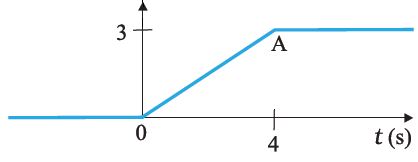Laws of Motion - Online Test
When the lift fall freely under gravity, a = g
Therefore Apparent weight, (We experience weight due to reaction)
This is the condition for weightlessness.
A man of mass 70 kg stands on a weighing scale in a lift which is moving upwards with a uniform speed of 10 m . What would be the reading if the lift mechanism failed and it hurtled down freely under gravity?
When the lift falls freely under gravity, a=g
Therefore Apparent weight,
This is the condition of weightlessness.


Initial velocity , between t= 0s and t=4s, the particle has a constant velocity,
therefore slope of OA is
At t= 0,Impulse=Change in momentum
=
At t= 4s, initial velocity is 3/4 m/s,
So, the Impulse =
Let,
T =tension in the string,
a= acceleration in the direction of force F.

m1=10 kg and m2= 20 kg
Therefore,common acceleration
Now the tension T in the string is
Let, T= tension on the string
a = acceleration, m1 = mass of light body= 10 kg and m2= mass of heavy body = 20 kg
Now the tension in the string will be,
Let, M = mass of nucleus at rest . m1 and m2 are masses of two smaller nuclei. v1 and v2 are the velocities of respective masses
Now, According to the law of conservation of momentum,
Initial momentum before disintegration = final momentum after disintegration
As masses and cannot be negative, and having opposite signs and so the two smaller nuclei move in opposite directions.
Two billiard balls each of mass 0.05 kg moving in opposite directions with speed 6 m collide and rebound with the same speed. What is the impulse imparted to each ball due to the other?
Impulse imparted to one ball by the other = change in momentum
= momentum after collision - momentum before collision
= {0.05 x 6} - {0.05x(-6)}
= 0.6 kg m s-1
A shell of mass 0.020 kg is fired by a gun of mass 100 kg. If the muzzle speed of the shell is 80 m , what is the recoil speed of the gun?
Massof shell,
Mass of gun,
Speed of shell,
Let V be the recoil speed of the gun. According to the law of conservation of momentum,
Initial momentum = Final momentum
Negative sign indicates that the gun moves backward as the bullet moves forward.
Let, m=0.25 kg, r= 1.5m and f= 40 rev/min = 40 rev /60 s= 2/3 rps
Tension in the string = Centripetal force
so,
